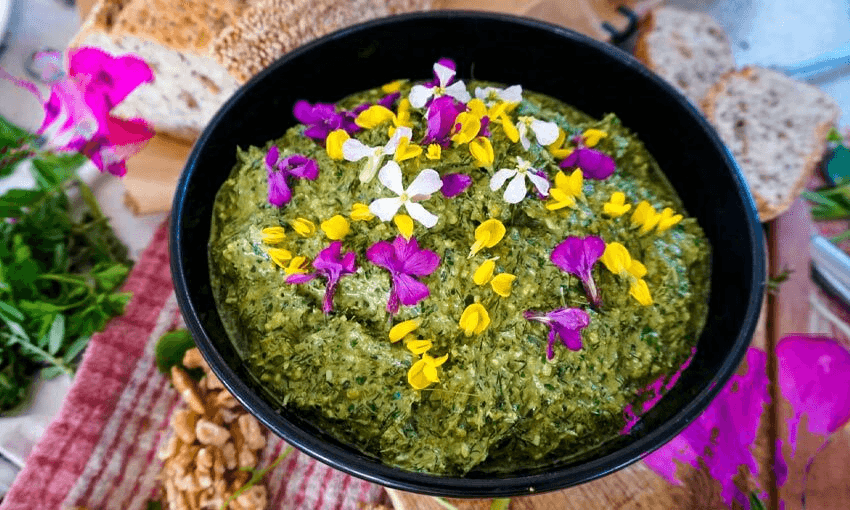Keen to take up foraging, but don’t know where to start? Olivia Sisson has got you covered with some easy-to-identify greens and a simple and delicious idea for what to do with them.
Facebook went down for six hours on Tuesday. A lot of us are still in lockdown of some form. The future remains uncertain. But the weather is warming up.
Basically what I’m saying is… it’s a great time to get into foraging. Edible greens and weeds are the best place to start.
Once you get familiar with a few species, you’ll soon be seeing forageable plants everywhere, and certainly on your stupid little walks.
After you’ve nibbled a bit and felt momentarily pleased with yourself, what’s next? If you’re keen to actually make something out of your foraged finds, try pesto. It’s delicious, easy, and full of leafy green nutrition.
Here’s a quick rundown of some forageable greens you can find up and down the country right now.
As a reminder, never eat anything you haven’t positively IDed first – I’ve included further resources, and the pesto recipe, at the end.
Dock
Of all the things you can forage, dock has gotta be one of the easiest. It grows almost everywhere – pastures, berms, anywhere that isn’t being mowed regularly.
The red veins that run down dock leaves make them easy to spot and so does their sheer size. The bigger leaves can get a bit tough. So pick the inner leaves which are more tender.
Narrow-leaved plantain
Like dock, narrow-leaved plantains are inconspicuous, innocuous, and freakin’ everywhere. They’re poster child #2 of the edible weeds family.
As the name suggests, these bad boys are long, slender, and elegant. They grow from a central point and each leaf features distinctive vertical ridges. In spring, narrow-leaved plantains send up seed heads that you can also eat.
Cleavers
Cleavers are easy to spot in that you don’t find them, they find you. Also called “sticky foot”, this clinging plant’s distinctive leaves have a velcro texture which is kinda off-putting.
But blend it up into a pesto, or a green smoothie, and cleavers will give you a refreshing, cucumber-like flavour.
They can be found in edge environments, berms, anywhere the soil has been disturbed.
Miner’s lettuce
This is one of my faves. It’s a wild, mild, super-crunchy micro-green. Find it in shaded areas, where the ground can hold a bit of moisture.
Miner’s lettuce is native to North America and gets its name from the California gold rush. Miners ate this vitamin C-packed green to ward off scurvy.
Transplant a bit to your garden and it will self-seed with vigour. I accidentally grew about two square metres of it over winter.
Chickweed
Chickweed is all over the place. A delicate, buttery green, she prefers damp, shaded environments. Chickweed’s leaves are very soft, the stem has a single line of fine hair, and there’s a tiny white flower at the top.
Great to eat in a salad or a sammie.
Onion weed
Onion makes everything, including pesto, better. As Charlotte Muru-Lanning put it, onion weed is the “misunderstood cute one” of the onion family.
Its three-cornered stems, pointed flowers and onion aroma make it easy to identify.
Wātakirihi/watercress
Watercress has a nice peppery flavour. Look for it along the edge of springs with fresh, flowing water. Don’t pick yellowed leaves, remove stems, and boil before using if you can’t be sure the area is uncontaminated.
Watercress’s distinctive leaf pattern and habitat will help you ID it.
Wild fennel
Wild fennel doesn’t place bulbs like cultivated fennel does. So don’t try to dig it up. But do keep an eye out for its lush, green fronds.
Crush a bit in your hand to release the smell and confirm what you’ve got. Wild fennel has a lovely, sweet, anise/liquorice scent and flavour.
Wild silverbeet/seabeet
Silverbeet is something of an escape artist. And can often be found on rocky coastlines.
Seashore silverbeet is extra special. It comes pre-seasoned thanks to salty ocean spray which is perfect for pesto.
Wild parsley
Parsley, like silverbeet, is also an escapee and has made its way out the garden and into our natural environment – especially around Canterbury and Welly.
I have heard of people mixing wild parsley up with poison hemlock, so don’t do that. Get familiar with hemlock’s yucky smell, and distinctive stem, which is blotchy and hollow.
How to turn your foraged fodder into pesto
Once you’ve got some foraged greens, swing by the supo for cheese, walnuts and olive oil. (I wasn’t prepared to make/forage these items, but it can be done. Walnuts and olives can also be found in many parts of NZ.)
On the cheese front, choose something hard and salty. Parmesan is the best, but I went with Grana Padano. It’s a bit cheaper.
From there…
- Sort your foraged greens. Remove random blades of grass that might have made their way into your basket. Cut away big stems.
- Grate the cheese. Toast the walnuts. Have plenty of olive oil at the ready.
- Wash your greens thoroughly. No need to dry them.
- Blend. Add greens, cheese, walnuts and drizzles of olive oil until you have a texture you’re happy with. Any blender should work, really. My George Foreman Mix & Go does the job, albeit unwillingly.
Once made, enjoy your foraged pesto on bread, crackers, pizza or pasta. Add lemon for a zing and to keep the colour up. Eat within a few days or freeze for the future.
For more info on foraging and help with IDs, check out my page, or Julia’s Edible Weeds.

